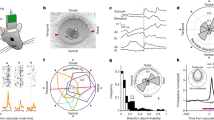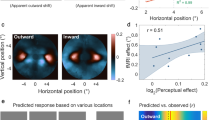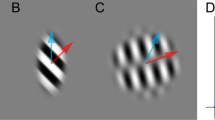Abstract
A PUZZLING feature of the visual system of primates is the occurrence of a multiplicity of separate ‘maps’ of the visual environment, each of which has its own independent set of afferent connections. Perhaps these maps represent an early stae in the analysis of visual information by the brain. Electrophysiological studies have shown that depth is analysed in V2 (area 18)(ref. 1), that colour-coded cells occur mainly in V4 and that motion in the visual field is analysed in the posterior bank of the superior temporal sulcus2 (Fig. 1). We report here an experiment which suggests that colour and movement are handled separately in the visual system and that information defined by wavelength cannot be processed by the brain's motion-detecting mechanisms. This finding is consistent with Zeki's demonstration that “cells of the movement area are not concerned with colour”2,3.
This is a preview of subscription content, access via your institution
Access options
Subscribe to this journal
Receive 51 print issues and online access
$199.00 per year
only $3.90 per issue
Buy this article
- Purchase on Springer Link
- Instant access to full article PDF
Prices may be subject to local taxes which are calculated during checkout
Similar content being viewed by others
References
Hubel, D. H. & Wiesel, T. N. Nature 225, 41–42 (1970).
Zeki, S. M. Proc. R. Soc. Lond. B 197, 195–223 (1977).
Zeki, S. M. J. Physiol., Lond. (1974).
Julesz, B. Foundations of Cyclopean Perception (University of Chicago Press, 1971).
Lu, C. & Fender, D. H. Invest. Ophthalmol. 11, 482–489 (1972).
Anstis, S. M. Vision Res. 10, 1411–1430 (1970).
Braddick, O. J. Vision Res. 13, 355–369 (1973).
Gregory, R. L. Perception 6, 113–119 (1977).
Ramachandran, V. S., Rao, V. M. & Vidyasagar, T. R. Nature 242, 412–414 (1973).
Nelson, J. I. J. theor. Biol. 49, 1–88 (1975).
Marr, D. & Poggio, T. Science 194, 283–287 (1976).
Gouras, P. J. Physiol., Lond. 199, 533–547 (1968); 204, 407–419 (1969).
De Monasterio, F. M., Gouras, P. & Tolhurst, D. J. Vision Res. 16, 674–678 (1976).
Dreher, B., Fukada, Y. & Rodieck, W. J. Physiol., Lond. 258, 433–452 (1976).
Author information
Authors and Affiliations
Rights and permissions
About this article
Cite this article
RAMACHANDRAN, V., GREGORY, R. Does colour provide an input to human motion perception?. Nature 275, 55–56 (1978). https://doi.org/10.1038/275055a0
Received:
Accepted:
Issue Date:
DOI: https://doi.org/10.1038/275055a0
This article is cited by
-
Color brings relief to human vision
Nature Neuroscience (2003)
-
Cortical mechanisms of colour vision
Nature Reviews Neuroscience (2003)
-
Visual illusions and neurobiology
Nature Reviews Neuroscience (2001)
-
Complete sparing of high-contrast color input to motion perception in cortical color blindness
Nature Neuroscience (1998)
-
Visual decomposition of colour through motion extrapolation
Nature (1997)
Comments
By submitting a comment you agree to abide by our Terms and Community Guidelines. If you find something abusive or that does not comply with our terms or guidelines please flag it as inappropriate.



